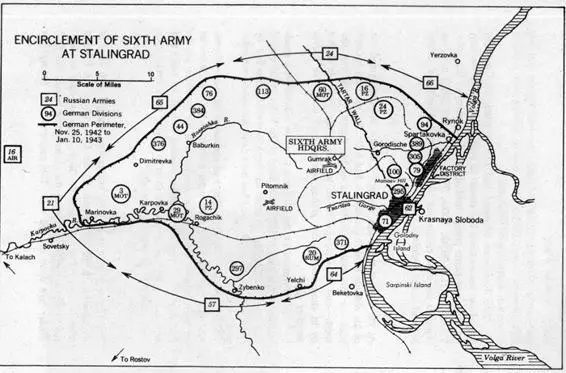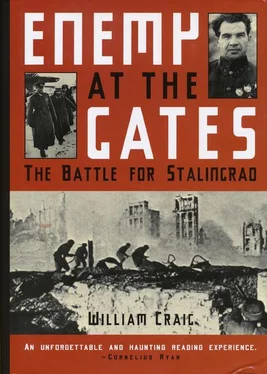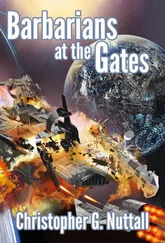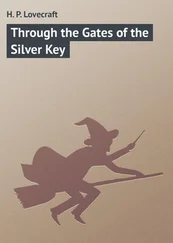In Red Army staff schools, such an operation had never been broached. Only Zhukov had practical experience in dealing with a surrounded enemy; at Khalkin Gol in Manchuria in 1939, he had successfully eliminated a portion of the Japanese Kwantung Army in a period of eleven days. But that force had totaled only one fourth of Paulus’s Sixth Army, now at bay, dangerous and defiant.
On November 28, Stalin called Zhukov to discuss the complex difficulties of dealing with the Stalingrad “fortress.” Once again, the premier needed his deputy’s calm analysis of an emergency. Zhukov answered with a telegram the next morning:
The trapped German forces are not likely to try to break out without help from a relief force….
The German command will evidently attempt to hold its positions at Stalingrad…. It will mass a relief force for a thrust to form a corridor to supply and eventually evacuate the trapped forces….
The trapped Stalingrad group should be cut in half….
But the Russians had no quick formula to achieve this goal. By now, seven Soviet armies were hugging the Sixth Army in a hostile embrace. The Sixty-sixth and Twenty-fourth pressed from the north; the Twenty-first and and Sixty-fifth barred exit to the west; the Fifty-seventh and Sixty-fourth pushed up from the south. In Stalingrad itself, Vassili Chuikov’s Sixty-second Army held the Volga shoreline as it had since September.
The Kessel was roughly thirty miles wide by twenty miles long, its western side tapered so that it resembled the snout of a giant anteater. In its middle, five corps headquarters dotted the steppe around Paulus while on the perimeter, weary divisions faced outward.
Manning the northern front closest to the Volga were the 24th and 16th Panzer divisions. To their left, stood the depleted 60th Motorized and 113th Infantry. In the northwestern sector, the nearly destroyed 76th, 384th, and 44th divisions licked assorted wounds from their retreat across the Don. At the extreme western edge, in the “snout,” the remnants of the 376th Division held a precarious foothold beside the 3rd Motorized. On the south side of the pocket, the 29th Motorized Division braced anxiously next to the 297th and 371st divisions. The 14th Panzer and 9th Flak divisions roamed the pocket in reserve, moving from position to position depending on the threat.
Two Rumanian divisions and one regiment of Croatians fleshed out the southern line closest to Stalingrad. And in the city, six exhausted battle groups held all but five percent of the town. There, the 71st, 295th, 100th, 79th, 305th, and 389th divisions clung to the same cellars and trenches they had occupied during September and October.
At the edge of the Volga, General Chuikov stormed in and out of his cliffside bunker cursing his bad luck. His war had become static—a backwash to the drama on the steppes to the west and south—and the Volga continued to plague him. Pack ice drifted by in enormous chunks, grating against each other like knives scraping glass.
On November 27, the disgusted Chuikov radioed front headquarters across the river: “The channel of the Volga to the east of Golodny and Sarpinski islands has been completely blocked by dense ice…. No ammunition has been delivered and no wounded evacuated.”
The offensive on the steppe had not solved all his problems. Not only that, but he smarted under a directive that put his troops on short rations. Chuikov was furious with his superiors and he told them, “…with every soldier wanting with all his heart and soul to broaden the bridgehead so as to breathe more freely, such economies seemed unjustified cruelty!”

The Germans were already on half rations. Caught with most of its supplies on the wrong side of the Don, where the Russian offensive had swept the steppe, the Sixth Army had only six days’ full rations for each man when the encirclement began. But Karl Binder had done his job well. The quartermaster’s foresight in moving his food, clothing, and cattle east, out of the danger zone made his 305th Division one of the few “rich” ones. Then Paulus ordered an accounting of available supplies, insisting on a “balancing” of provisions among the units. Binder was outraged. He had little sympathy for those who had failed to anticipate the calamity. Nevertheless he gave up part of his reserves: three hundred head of cattle, eighty sacks of flour, butter, honey, canned meat, sausage, clothing to destitute neighbors. Binder felt his labors for his own troops had been in vain.
Veterinarian Herbert Rentsch had a different problem. His horses, Russian panjes and Belgian drafts, were going to the butchers to sustain the army. The doctor was glad he had not sent four hundred animals back to the Ukraine just before the pocket closed.
He also had a personal crisis. His own horse, Lore, was showing the effects of inadequate grazing. Her rib cage showed through her winter coat. No one had yet forced him to include Lore in the list of horses to be killed, and he refused to think about that possibility.
At the western edge of the pocket, the last German regiments and companies ran across the bridges over the Don and passed through the rear guard holding the Russians in check. The last German soldier to cross the Don toward Stalingrad was a first lieutenant named Mutius. During the early morning of November 29, he looked back at the dark steppe. At 3:20 A.M., he pushed down a plunger and the bridge at Lutschinski burst into an orange ball of flame that lit the shore on both sides, illuminating a long line of German vehicles moving east, into the Kessel.
On November 30, forty He-111 bombers joined the Ju-52 transports on the run to Stalingrad. It took fifty minutes to cross the snowfields of the steppe and follow the radio beacon to the landing strip at Pitomnik, which was a beehive of activity. Mechanics swarmed over the planes as soon as they landed, unloading equipment swiftly, even siphoning off extra gas from wing tanks to replenish the fuel of the armored vehicles inside the pocket. On that day, almost a hundred tons of vital supplies arrived. Paulus was encouraged to believe that the Luftwaffe was about to meet his demands. It was not. Another weather front moved in and for the next two days, hardly a plane made it to Pitomnik.
Since the beginning of General Yeremenko’s offensive, Lt. Hersch Gurewicz had stayed in place on the right shoulder of the breakthrough, the sector closest to the city. When Soviet armies probed the southern perimeter of the Kessel on December 2, he jumped into an observation plane and took off to scout the terrain.
Beneath Gurewicz, the German lines appeared as dark smudges, irregular scars. While marking the data on his map, a sudden burst of antiaircraft fire shook the aircraft, which spun wildly out of control. Gurewicz braced himself in his cramped seat and the pilot managed to pull out of the dive only to crash-land extremely hard. A tremendous explosion smashed Gurewicz unconscious. Hours later, he woke to find the cabin a shambles and the pilot dead. Gureivicz looked down at his pants, soaked through with blood. His right leg throbbed; it was bent almost at a 45-degree angle to his body.
He worked feverishly to get out of the plane, but the pilot’s body kept falling over on him and Gurewicz felt a surge of panic. Finally he threw his weight against the door and fell out into a snowdrift. His leg hung by one piece of skin above the knee; he dragged it after him with his right hand. His mind fully alert, he suddenly realized that the explosion which ripped the plane apart was a mine, and that he was alone in no-man’s-land, in a minefield.
Читать дальше













